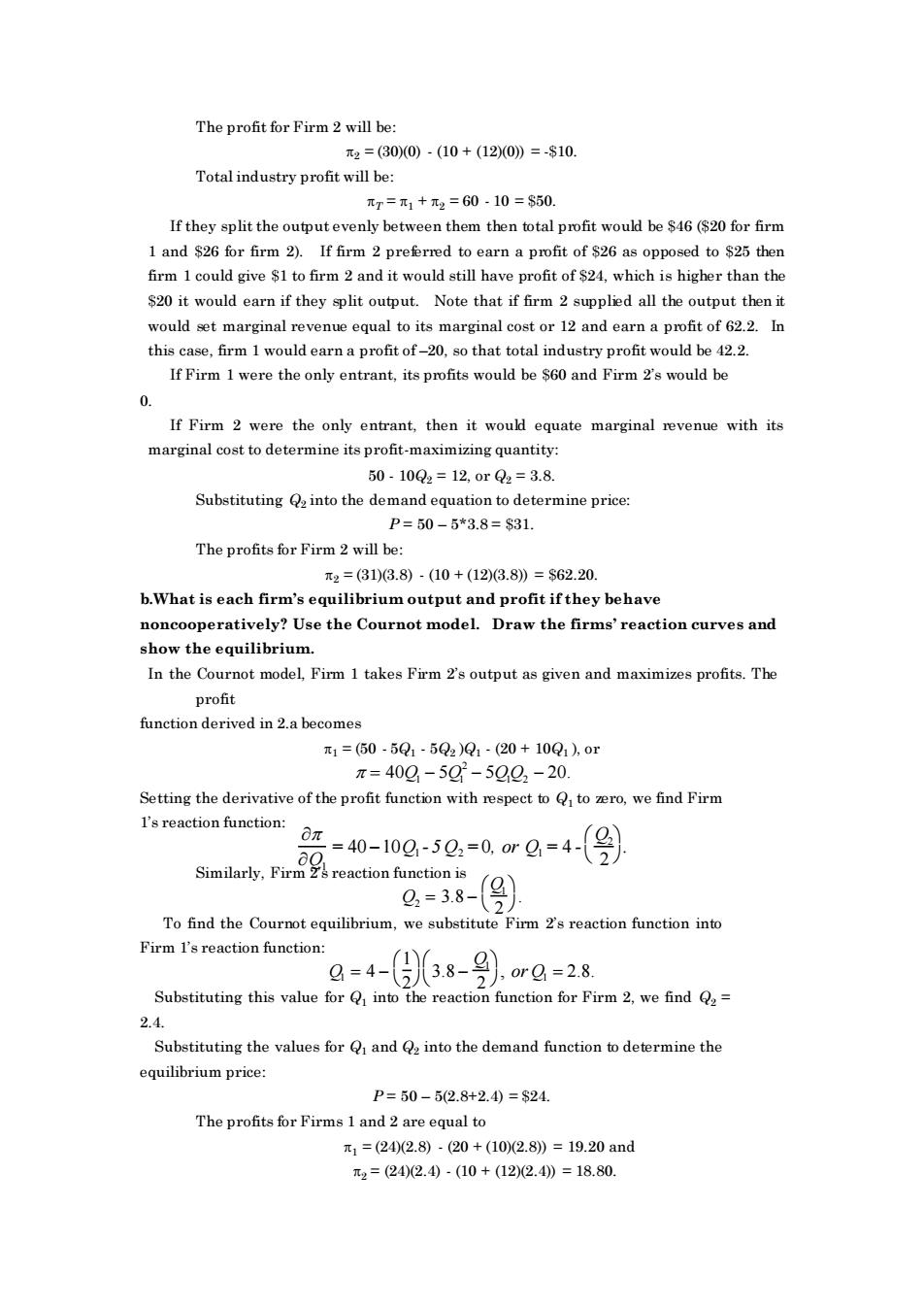正在加载图片...

The profit for Firm 2 will be: 2=(300)-(10+(120=-$10 Total industry profit will be: Tr=元1+元2=60-10=$50. If they split the output evenly between them then total profit would be $46($20 for firm 1 and $2G for firm 2). If firm 2 preferred to earn a profit of $2G as oppo ed to$25 the firm 1 could give $1 to firm 2 and it would still have profit of $24.which is higher than the $20 it would earn if they split output.Note that if firm 2 supplied all the output then it would t marginal revenue equal to its marginal cost or 12 and earn a profit of 62.2.In this case,firm I woulde If Firm I were the only entrant,its profits would be $60 and Firm 2's would be 0 If Firm 2 were the only entrant.then it would equate marginal revenue with its marginal co to determine its 50.10Q2=12.0rQ2=3.8. Substituting into the demand equation to determine price: P=50-5*3.8=s31 The profits for Firm 2 will be: 2=8103.8)-(10+(12)6.8》=$62.20 b.What is each firm's equilibrium output and profit ifthey behave noncooperatively?Use the Cournot model.Draw the firms'reaction curves and show the equilibrium. In the Cournot model,Firm I takes Firm 2's output as given and maximizes profits.The profit function derived in 2.a becomes 元1=(60.5015Q2)1(20+10Q1,0 π=400-5g-5002-20 Setting the derivative of the profit function with respect to to ero we find Firm I's reaction function: =40-100,-52=0,or=4-2 O =38-(g To find the Cournot equilibrium,we substitute Firm 2's reaction function into Firm I's reaction function: g-4-5 38-9).r=28 Substituting this value for Q into the reaction function for Firm 2,we find , 2.4 Substituting the values for a,and o.into the demand function to determine the equilibrium price P=50-52.8+2.4)=$24 The profits for Firms 1 and 2 are equal to x1=(242.8)-(20+(102.8)=19.20and 2=(2402.4-(10+(122.4=18.80 The profit for Firm 2 will be: 2 = (30)(0) - (10 + (12)(0)) = -$10. Total industry profit will be: T = 1 + 2 = 60 - 10 = $50. If they split the output evenly between them then total profit would be $46 ($20 for firm 1 and $26 for firm 2). If firm 2 preferred to earn a profit of $26 as opposed to $25 then firm 1 could give $1 to firm 2 and it would still have profit of $24, which is higher than the $20 it would earn if they split output. Note that if firm 2 supplied all the output then it would set marginal revenue equal to its marginal cost or 12 and earn a profit of 62.2. In this case, firm 1 would earn a profit of –20, so that total industry profit would be 42.2. If Firm 1 were the only entrant, its profits would be $60 and Firm 2’s would be 0. If Firm 2 were the only entrant, then it would equate marginal revenue with its marginal cost to determine its profit-maximizing quantity: 50 - 10Q2 = 12, or Q2 = 3.8. Substituting Q2 into the demand equation to determine price: P = 50 – 5*3.8 = $31. The profits for Firm 2 will be: 2 = (31)(3.8) - (10 + (12)(3.8)) = $62.20. b.What is each firm’s equilibrium output and profit if they behave noncooperatively? Use the Cournot model. Draw the firms’ reaction curves and show the equilibrium. In the Cournot model, Firm 1 takes Firm 2’s output as given and maximizes profits. The profit function derived in 2.a becomes 1 = (50 - 5Q1 - 5Q2 )Q1 - (20 + 10Q1 ), or = 40Q1 − 5Q1 2 − 5Q1Q2 − 20. Setting the derivative of the profit function with respect to Q1 to zero, we find Firm 1’s reaction function: Q1 = 40 −10Q1 - 5Q2 =0, or Q1 = 4 - Q2 2 . Similarly, Firm 2’s reaction function is Q2 = 3.8 − Q1 2 . To find the Cournot equilibrium, we substitute Firm 2’s reaction function into Firm 1’s reaction function: Q1 = 4 − 1 2 3.8 − Q1 2 , or Q1 = 2.8. Substituting this value for Q1 into the reaction function for Firm 2, we find Q2 = 2.4. Substituting the values for Q1 and Q2 into the demand function to determine the equilibrium price: P = 50 – 5(2.8+2.4) = $24. The profits for Firms 1 and 2 are equal to 1 = (24)(2.8) - (20 + (10)(2.8)) = 19.20 and 2 = (24)(2.4) - (10 + (12)(2.4)) = 18.80